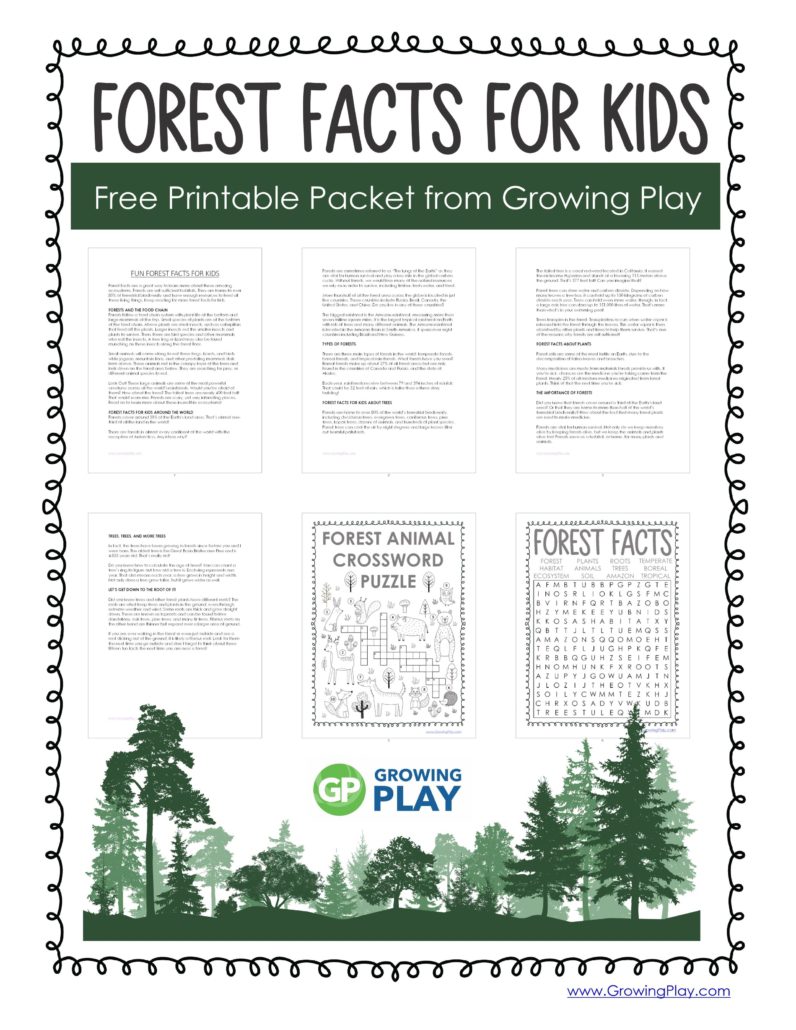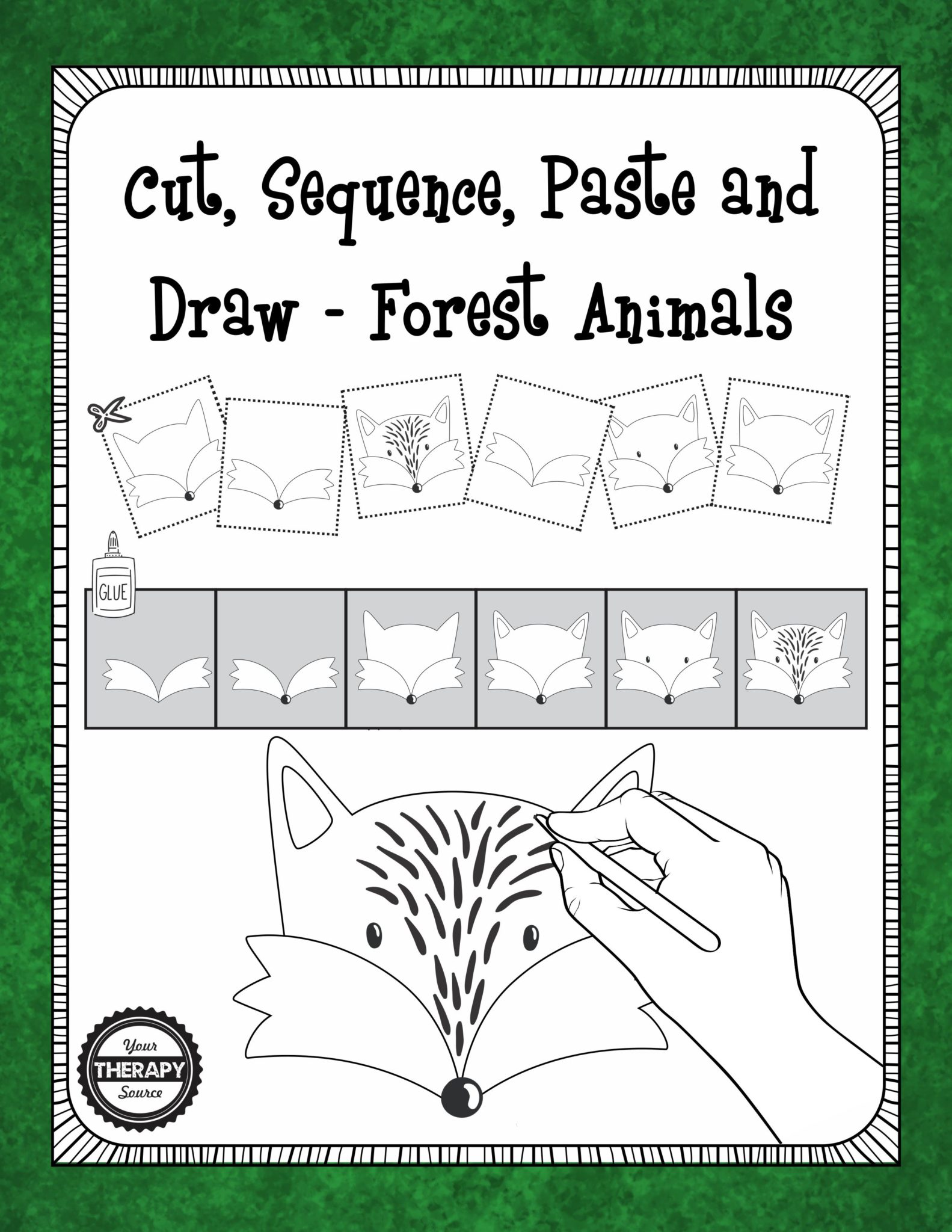Fun Forest Facts for Kids
Forest facts are a great way to learn more about these amazing ecosystems. Forests are self-sufficient habitats. They are home to over 80% of terrestrial biodiversity and have enough resources to feed all these living things. Keep reading for more forest facts for kids. Download your FREE packet at the bottom of the blog post. It includes a reading packet along with a crossword puzzle and word search!

Forests and the Food Chain
Forests follow a food chain system with plant life at the bottom and large mammals at the top. Small species of plants are at the bottom of the food chain. Above plants are small insects, such as caterpillars that feed off the plants. Larger insects eat the smaller insects and plants to survive. Then, there are bird species and other mammals who eat the insects. A tree frog or lizard may also be found munching on these insects along the forest floor.
Small animals will come along to eat these frogs, lizards, and birds while jaguars, mountain lions, and other predating mammals stalk from above. These animals rest in the canopy layer of the trees and look down on the forest area below. They are searching for prey, or different animal species to eat.
Look Out! These large animals are some of the most powerful creatures across all the world’s rainforests. Would you be afraid of them? How about the trees? The tallest trees are nearly 400 feet tall! That would scare me. Forests are scary, yet very interesting places. Read on to learn more about these incredible ecosystems!
Forest Facts for Kids Around the World
Forests cover around 31% of the Earth’s land area. That’s almost one-third of all the land in the world! We celebrate forest on March 21 when it is International Forest Day.
There are forests in almost every continent of the world with the exception of Antarctica. Any ideas why?
Forests are sometimes referred to as “The lungs of the Earth” as they are vital for human survival and play a key role in the global carbon cycle. Without forests, we would lose many of the natural resources we rely on in order to survive, including timber, fresh water, and food.
More than half of all the forest area across the globe is located in just five countries. These countries include Russia, Brazil, Canada, the United States, and China. Do you live in any of these countries?
The biggest rainforest is the Amazon rainforest, measuring more than seven million square miles. It is the largest tropical rainforest on Earth with lots of trees and many different animals. The Amazon rainforest is located in the Amazon Basin in South America. It spans over eight countries including Brazil and New Guinea.

Cut Sequence Paste and Draw Forest Animals
Types of Forests
There are three main types of forests in the world: temperate forests, boreal forests, and tropical rain forests. What forests have you seen?
Boreal forests make up about 27% of all forest areas but are only found in the countries of Canada and Russia, and the state of Alaska.
Each year, rainforests receive between 79 and 394 inches of rainfall. That could be 32 feet of rain, which is taller than a three-story building!
Forest Facts for Kids about Trees
Forests are home to over 80% of the world’s terrestrial biodiversity, including deciduous trees, evergreen trees, coniferous trees, pine trees, kapok trees, dozens of animals, and hundreds of plant species.
Forest trees can cool the air by eight degrees and large leaves filter out harmful pollutants.
The tallest tree is a coast redwood located in California. It earned the nickname Hyperion and stands at a towering 115 meters above the ground. That’s 377 feet tall! Can you imagine that?
Forest trees can store water and carbon dioxide. Depending on how many leaves a tree has, it can hold up to 150 kilograms of carbon dioxide each year. Trees can hold even more water, though. In fact, a large oak tree can store up to 151,000 liters of water. That’s more than what’s in your swimming pool!
Trees transpire in the forest. Transpiration occurs when water vapor is released into the forest through the leaves. This water vapor is then absorbed by other plants and trees to help them survive. That’s one of the reasons why forests are self-sufficient!
Forest Facts about Plants
Forest soils are some of the most fertile on Earth, due to the decomposition of fallen leaves and branches.
Many medicines are made from materials forests provide us with. If you’re sick, chances are the medicine you’re taking came from the forest. Nearly 25% of all modern medicines originated from forest plants. Think of that the next time you’re sick.
The Importance of Forests
Did you know that forests cover around a third of the Earth’s land area? Or that they are home to more than half of the world’s terrestrial biodiversity? How about the fact that many forest plants are used to make medicine. Forests are vital for human survival. Not only do we keep ourselves alive by keeping forests alive, but we keep the animals and plants alive too! Forests serve as a habitat, or home, for many plants and animals.

Animal Care Pretend Play Packet
Trees, Trees, and More Trees
In fact, the trees have been growing in forests since before you and I were born. The oldest tree is the Great Basin Bristlecone Pine and is 4,853 years old. That’s really old! Do you know how to calculate the age of trees? You can count a tree’s ring to figure out how old a tree is. Each ring represents one year. That also means each year, a tree grows in height and width. Not only does a tree grow taller, but it grows wider as well.
Let’s Get Down to the Root of it!
Did you know trees and other forest plants have different roots? The roots are what keep trees and plants in the ground, even through extreme weather and wind. Some roots are thick and grow straight down. These are known as taproots and can be found below dandelions, oak trees, pine trees, and many fir trees. Fibrous roots on the other hand are thinner but expand over a larger area of ground. If you are ever walking in the forest or even just outside and see a root sticking out of the ground, it is likely a fibrous root. Look for them the next time you go outside and don’t forget to think about these fifteen fun facts the next time you are near a forest!
HOW TO ACCESS FREE FOREST FACTS FOR KIDS ACTIVITIES!!!!
1. Sign up to receive the weekly newsletter and other announcements from Growing Play at the bottom of this post. If you already subscribe, just enter your email and you will get access to the freebie too!
2. Download the fun and FREE forest printables!
3. Print, read and solve the puzzles!

WANT MORE FUN FACTS FOR KIDS?
Check 100 fun facts for kids here and browse all the other topics at the bottom of the post.


